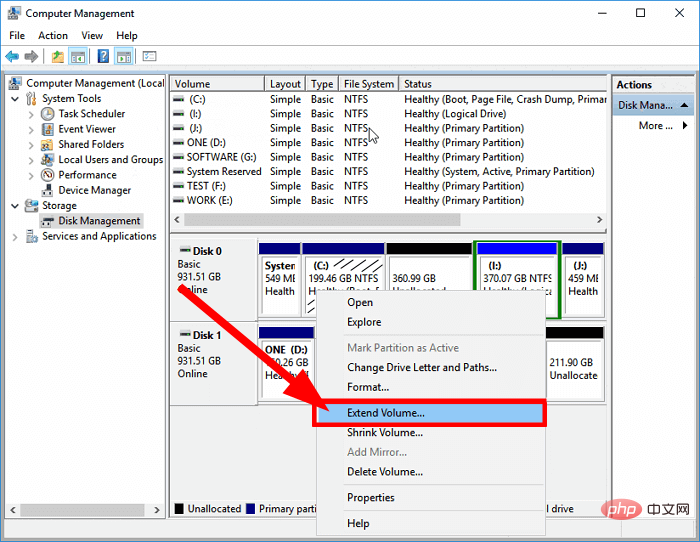 Operation and Maintenance
Operation and Maintenance Linux Operation and Maintenance
Linux Operation and Maintenance Introductory Tutorial: A quick guide to setting up a web server on CentOS
Introductory Tutorial: A quick guide to setting up a web server on CentOSEntry-level tutorial: A quick guide to building a web server on CentOS
Introduction:
In today's Internet era, building your own web server has become a need for many people. This article will introduce you to how to build a web server on the CentOS operating system, and provide code examples to help readers quickly implement it.
Step one: Install and configure Apache
-
Open the terminal and install the Apache server through the following command:
sudo yum install httpd
-
Install After completion, start the Apache service and set it to start automatically at boot:
sudo systemctl start httpd sudo systemctl enable httpd
- Verify whether Apache is successfully installed:
Enter the IP address or domain name of the server in the browser, if it can be seen The Apache welcome page indicates that the installation is successful.
Step 2: Install and configure MySQL
-
Use the following command to install the MySQL database:
sudo yum install mysql-server
-
Install After completion, start the MySQL service and set it to start automatically at boot:
sudo systemctl start mysqld sudo systemctl enable mysqld
-
Perform basic security settings, enter the following commands and follow the prompts:
sudo mysql_secure_installation
-
Use the following command for MySQL account management:
sudo mysql
After entering the MySQL command line mode, you can create new users, authorizations, etc.
Step Three: Install and Configure PHP
-
Use the following command to install PHP:
sudo yum install php php-mysql
-
After the installation is complete, restart the Apache service:
sudo systemctl restart httpd
-
Create a php test file and enter the following content:
<?php phpinfo(); ?>
Save and exit. Access this file in the browser. If you can see the PHP configuration information, the installation is successful.
Step 4: Configure the virtual host
-
Edit the Apache configuration file and enter the following command:
sudo vi /etc/httpd/conf/httpd.conf
-
Find the two lines
DocumentRootandDirectoryand modify them to the required directory path, for example:DocumentRoot /var/www/html/example <Directory "/var/www/html/example">
-
Save and exit, and Restart the Apache service:
sudo systemctl restart httpd
- Create the example folder in the /var/www/html directory and place the website source code file in this folder.
Summary:
Through the above four steps, we successfully built a web server on CentOS. Readers can further configure and adjust according to their own needs, such as adding SSL certificates, setting firewall rules, etc. I hope this article can help beginners who are building web servers, so that everyone can get started quickly and enjoy the fun of web development.
Code example:
<!DOCTYPE html> <html> <body> <?php echo "Hello World!"; ?> </body> </html>
The above is a simple PHP sample code that outputs Hello World to the browser. Readers can access this code file by setting a virtual host in the Apache configuration file.
The above is the detailed content of Introductory Tutorial: A quick guide to setting up a web server on CentOS. For more information, please follow other related articles on the PHP Chinese website!
 centos用什么命令可查版本号Mar 03, 2022 pm 06:10 PM
centos用什么命令可查版本号Mar 03, 2022 pm 06:10 PM查版本号的命令:1、“cat /etc/issue”或“cat /etc/redhat-release”,可输出centos版本号;2、“cat /proc/version”、“uname -a”或“uname -r”,可输出内核版本号。
 centos重启网卡的方法是什么Feb 22, 2023 pm 04:00 PM
centos重启网卡的方法是什么Feb 22, 2023 pm 04:00 PMcentos重启网卡的方法:1、对于centos6的网卡重启命令是“service network restart”;2、对于centos7的网卡重启命令是“systemctl restart network”。
 centos php怎么安装opcacheJan 19, 2023 am 09:50 AM
centos php怎么安装opcacheJan 19, 2023 am 09:50 AMcentos php安装opcache的方法:1、执行“yum list php73* | grep opcache”命令;2、通过“yum install php73-php-opcache.x86_64”安装opcache;3、使用“find / -name opcache.so”查找“opcache.so”的位置并将其移动到php的扩展目录即可。
 centos 怎么离线安装 mysqlFeb 15, 2023 am 09:56 AM
centos 怎么离线安装 mysqlFeb 15, 2023 am 09:56 AMcentos离线安装mysql的方法:1、将lib中的所有依赖上传到linux中,并用yum命令进行安装;2、解压MySQL并把文件复制到想要安装的目录;3、修改my.cnf配置文件;4、复制启动脚本到资源目录并修改启动脚本;5、将mysqld服务加入到系统服务里面;6、将mysql客户端配置到环境变量中,并使配置生效即可。
 centos 怎么删除 phpFeb 24, 2021 am 09:15 AM
centos 怎么删除 phpFeb 24, 2021 am 09:15 AMcentos删除php的方法:1、通过“#rpm -qa|grep php”命令查看全部php软件包;2、通过“rpm -e”命令卸载相应的依赖项;3、重新使用“php -v”命令查看版本信息即可。
 centos 7安装不出现界面怎么办Jan 03, 2023 pm 05:33 PM
centos 7安装不出现界面怎么办Jan 03, 2023 pm 05:33 PMcentos7安装不出现界面的解决办法:1、选择“Install CentOS 7”,按“e”进入启动引导界面;2、 将“inst.stage2=hd:LABEL=CentOS\x207\x20x86_64”改为“linux dd”;3、重新进入“Install CentOS 7”,按“e”将“hd:”后的字符替换成“/dev/sdd4”,然后按“Ctrl+x”执行即可。
 centos中ls命令不显示颜色怎么办Apr 20, 2022 pm 03:16 PM
centos中ls命令不显示颜色怎么办Apr 20, 2022 pm 03:16 PM方法:1、利用“vim ~/.bashrc”编辑用户目录(~)下的“.bashrc”文件;2、在文件内添加“alias ls="ls --color"”;3、利用“:wq!”命令保存文件内的更改;4、“exit”命令退出终端后重新连接即可。
 如何在 CentOS 9 Stream 上安装 NagiosMay 10, 2023 pm 07:58 PM
如何在 CentOS 9 Stream 上安装 NagiosMay 10, 2023 pm 07:58 PM我们的PC中有一个磁盘驱动器专门用于所有与Windows操作系统相关的安装。该驱动器通常是C驱动器。如果您还在PC的C盘上安装了最新的Windows11操作系统,那么所有系统更新(很可能是您安装的所有软件)都会将其所有文件存储在C盘中。因此,保持此驱动器没有垃圾文件并在C驱动器中拥有足够的存储空间变得非常重要,因为该驱动器拥有的空间越多,您的Windows11操作系统运行起来就越顺畅。但是您可以在磁盘驱动器上增加多少空间以及可以删除多少文件是有限制的。在这种情况下,


Hot AI Tools

Undresser.AI Undress
AI-powered app for creating realistic nude photos

AI Clothes Remover
Online AI tool for removing clothes from photos.

Undress AI Tool
Undress images for free

Clothoff.io
AI clothes remover

AI Hentai Generator
Generate AI Hentai for free.

Hot Article

Hot Tools

SublimeText3 English version
Recommended: Win version, supports code prompts!

mPDF
mPDF is a PHP library that can generate PDF files from UTF-8 encoded HTML. The original author, Ian Back, wrote mPDF to output PDF files "on the fly" from his website and handle different languages. It is slower than original scripts like HTML2FPDF and produces larger files when using Unicode fonts, but supports CSS styles etc. and has a lot of enhancements. Supports almost all languages, including RTL (Arabic and Hebrew) and CJK (Chinese, Japanese and Korean). Supports nested block-level elements (such as P, DIV),

Zend Studio 13.0.1
Powerful PHP integrated development environment

Atom editor mac version download
The most popular open source editor

MinGW - Minimalist GNU for Windows
This project is in the process of being migrated to osdn.net/projects/mingw, you can continue to follow us there. MinGW: A native Windows port of the GNU Compiler Collection (GCC), freely distributable import libraries and header files for building native Windows applications; includes extensions to the MSVC runtime to support C99 functionality. All MinGW software can run on 64-bit Windows platforms.





